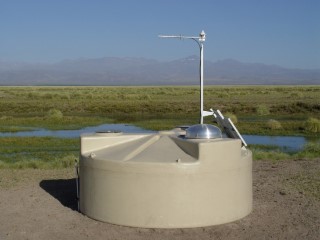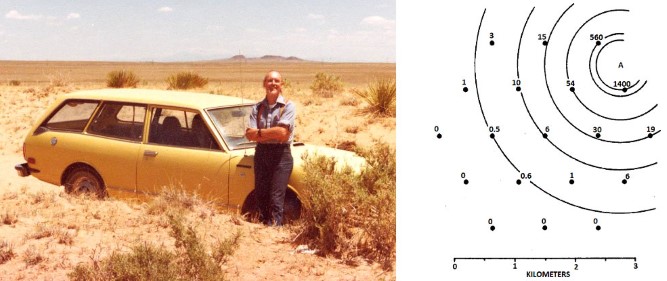Auger Observatory Animation: This animation models how an extensive air shower (EAS) is detected by the Pierre Auger Cosmic Ray Observatory Engineering Array. The cosmic ray particles spread out to form a shower front. The shower front is illustrated using green dots to represent electrons and positrons, and red dots to represent muons. Yellow indicates that particles have been detected coincidentally by one of the water tank detectors. Slight differences in the detection times at the various tank positions allow scientists to determine the cosmic ray arrival direction. See the sketch of the cosmic ray creating an air shower and heading towards the detector on the previous page.
Credit: Pierre Auger Collaboration
Peter Bassi, a visiting scientist from Italy, and I set up a small experiment on the roof of the physics building to test Rossi’s idea. Our detectors were three five-gallon cans filled with toluene and placed 30-feet apart in a line. Each was fitted with a photomultiplier connected by cable to a central station. When an EAS caused scintillation flashes in all three detectors, the resulting electrical pulses from the photomultipliers were displayed on an oscilloscope viewed by an automatic film camera. Measurements on the developed film of the relative size and spacing of the pulses recorded from each event proved that “fast timing” and “density sampling” could yield arrival directions within a few degrees and shower sizes within a few percent. So they became the basis for a series of M.I.T. air shower experiments by members of our group, first at a site near Boston, and then in India, Bolivia, and New Mexico. The travel experiences were great, and the experiments worked well. The results determined the primary energy spectrum up to 1019 eV, and yielded an all-sky survey of arrival directions, but no certain preferred direction.
Auger Detector: The Pierre Auger Observatory has 1,600 water tanks arrayed throughout a 1,200-square mile area in western Argentina. Each of the 3,000-gallon tanks is a particle detector for capturing cosmic rays. The Auger Observatory uses both water tanks and optical detectors to measure the cosmic ray air showers.
Credit: Pierre Auger Collaboration
John Linsley directed the largest of the M.I.T. air shower experiments, which was located on the Volcano Ranch in New Mexico. In 1963 he reported evidence of a primary cosmic-ray particle with 1020 eV, the highest energy in a single particle that had ever been observed, enough to lift a golf ball twelve feet!
There have been many air shower experiments using “fast timing’ and “density sampling.” There is now a huge one at the Pierre Auger Observatory in Argentina, involving dozens of international collaborators, with an array of 1600 detectors spread over an area of 1,200 square miles. The collaboration has reported evidence that the energy spectrum cuts off near 1021 eV and that some arrival directions are clustered around certain extragalactic objects. Whereas we could not find any evidence for particular sources of cosmic rays in our experiments, there is now some evidence that there are particular sources of these particles.
Volcano Ranch, New Mexico: (Left) John Linsley at Volcano Ranch. On February 22, 1962, Linsley observed an air shower created by a primary particle with an energy greater than 1020 eV, the highest energy cosmic ray observed up to that point. If a particle of this energy was created within the galaxy, it could not be contained in the galaxy. Linsley’s observations at Volcano Ranch suggested that not all cosmic rays are confined within the galaxy, as had been previously supposed. (Right) The plan of Volcano Ranch array in 1962, as it looked when Linsley made his observation. The circles represent 3.3 m2 scintillation detectors. Numbers near circles are shower densities (particles/m2) registered in the event. Point 'A' is the estimated location of the shower core.
Credit: John Linsley Papers. Fermilab History and Archives Project, Fermi National Accelerator Laboratory, Batavia, IL




